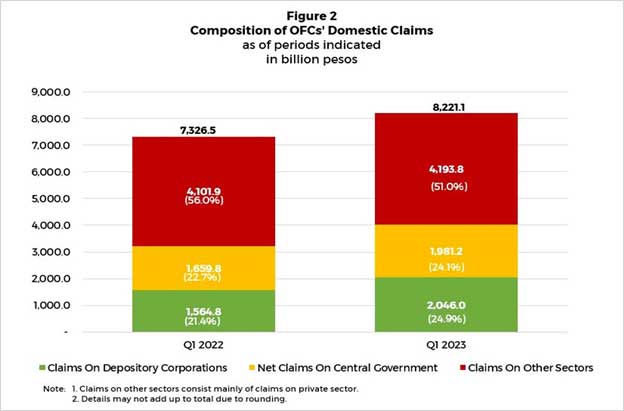Based on preliminary results of the Other Financial Corporations Survey (OFCS), the domestic claims of the OFCs rose by 12.2 percent to ₱8,221.1 billion in Q1 2023 from ₱7,326.5 billion in Q1 2022 (Figure 1).[1]

The growth in the OFCs’ domestic claims in Q1 2023 was due to higher claims on the depository corporations (DCs), the central government and the other sectors.[2] In particular, the OFCs’ claims on DCs expanded significantly, owing mainly to the growth in the sector’s deposits in banks and holdings of bank-issued equity shares. Similarly, claims on the central government rose, following OFCs’ increased holdings of government securities. Likewise, the OFCs’ claims on other sectors, particularly the private sector, grew slightly, primarily on account of increased loans extended to the households and the nonfinancial corporations.[3]
By component, claims on other sectors, specifically the private sector, comprised the bulk of the OFCs’ domestic claims during the quarter, followed by claims on DCs and the central government (Figure 2).

Meanwhile, the net foreign assets of the OFCs grew by 20.8 percent to ₱304.3 billion in Q1 2023 from ₱252.0 billion in Q1 2022. The claims on nonresidents expanded mainly due to the OFCs’ increased investments in debt securities issued by nonresidents. The sector’s liabilities to nonresidents grew slightly due to higher reinsurance payables to nonresidents.[4]
The expansion in the OFCs’ gross assets was funded mainly by its issuances of shares and other equity to other sectors.
[1] The OFCS is a comprehensive measure of the claims and liabilities of the OFCs. OFCs refer to institutional units providing financial services other than banks, non-banks with quasi-banking functions, nonstock savings and loan associations, and the central bank. These institutional units are comprised of non-money market funds of trust institutions, trust corporations, and investment companies, private and public insurance corporations, holding companies, government-owned or -controlled corporations engaged in financial intermediation, and other financial intermediaries and auxiliaries.
[2] The other sectors is comprised of (a) state and local government, (b) public nonfinancial corporations, and (c) private sector.
[3] The private sector is composed of other nonfinancial corporations, households and non-profit institutions serving households. The other nonfinancial corporations refer to private corporations and quasi-corporations whose principal activity is the production of market goods or nonfinancial services.
[4] Reinsurance liabilities are comprised of premiums due to reinsurers, which represent premiums payable by the insurance companies to all their reinsurers.




















